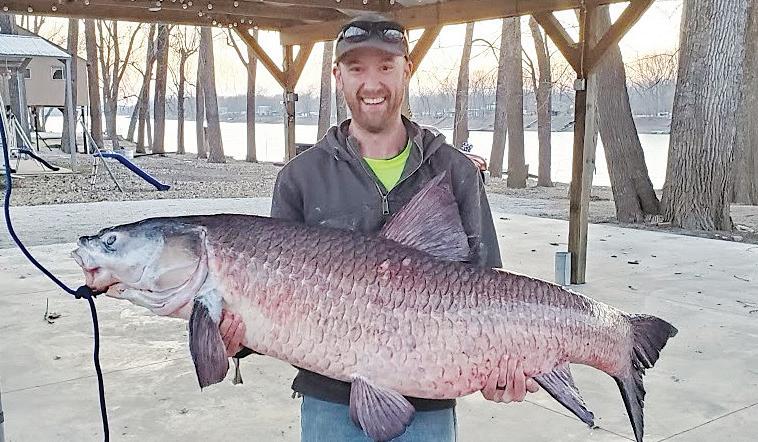
22 minute read
Black carp surprise
Surprise! It’s an invasive black carp
Jesse Hughes of Bonnots Mill in Osage County, MO, was fishing for catfish with friends on March 4 when he hooked into a 112-pound black carp.
What a surprise – the Missouri Department of Conservation lists black carp on its prohibited species list, which may not be imported, exported, transported, sold, purchased or possessed alive in Missouri without approval of the MDC director.
“We hooked into it and knew it was something big, but I originally thought it was a catfish,” Hughes said. “It was the first I’d heard of a black carp. I didn’t know anything about it, so this has been quite the learning experience.”
Black carp are an invasive fish from Asia that eats mussels and snails. The fish damage populations of native mollusks, many of which are critically endangered.
There is a strong possibility the species is becoming established, with breeding populations, in North America.
Black carp have been found in the Mississippi River system, including the Osage
River, where in 1994 about 30 reportedly escaped from a fish farm during a high-water event and entered that river.
SUPPOSED TO BE STERILE
Most of the black carp in the U.S. were introduced to control problematic snail populations in commercial fisheries, and these individuals are presumably sterile.
Yet fertile individuals can be present, too. Given that black carp can live for 15 years, even the sterile individuals can present a serious long-term problem for native mollusk populations.
“If anglers happen to catch black carp, or any invasive fish, while fishing in Missouri waters, it’s imperative to contact their local conservation agent,” MDC Fisheries Programs Specialist Andrew Branson said. “That way, our fisheries staff can be notified and monitor the spread of these destructive species.”
The black carp caught by Hughes is being studied by the U.S. Geological Survey.
“It’s a little disappointing, as I don’t think I’ll ever catch a fish that big again,” Hughes said with a grin. “But at least it’s one less invasive fish in Missouri waters.”
NOT TRULY BLACK
Black carp appear similar to the common grass carp, but the black carp is darker, though not truly black, and some report the adult black carp has a relatively narrower snout. It also has large pharyngeal teeth, or throat teeth, that resemble human molars. These teeth are used to crush the shells of mollusk and prey.
Jesse Hughes of Osage County was trying for catfish when he hauled in this 112-pound black carp. – MDC photo
To learn more about invasive species, go online to https://
short.mdc.mo.gov/ZeV.
OUTDOOR
May-June 2021
GUIDE
MAGAZINE
HUNTING • FISHING • CAMPING • BOATING • SHOOTING • TRAVEL
Volume 29, No. 3 • Published six times a year Office: 505 S. Ewing, St. Louis, MO 63103 News department — 618-972-3744 www.outdoorguidemagazine.com e-mail: news@outdoor-guide.com
COVER created by Kathy Crowe, graphic designer.
Carl Green, editor – carl@labortribune.com Bob Whitehead, editor emer. – ogmbobw@aol.com Kathy Crowe, graphic designer John Winkelman, associate editor — ogmjohnw@aol.com Lynn Fowler, circulation manager
— Account executives — Dan Braun, marketing director 314-256-4136 Lauren Marshall 314-614-5175
Darrell Taylor Ray Eye Brent Frazee Brandon Butler — Regional and specialty editors —
Curt Hicken Bill Cooper Thayne Smith Steve Jones
Bill Seibel John Neporadny Jr. Rick Story T. J. Mullin Larry Whiteley Ted Nugent Ron Bice
– In Memoriam —
Joel Vance • Ron Henry Strait • Jared Billings • Charlie Farmer • Richard Engelke • Mark Hubbard • Spence Turner • Hank Reifeiss Kay Hively • Bill Harmon • Barbara Perry Lawton • Danny Hicks • Ron Kruger • TJ Stallings • John Sloan
— Staff writers —
Scott Pauley Claudette Roper Kenneth Kieser Don Gasaway Tim Huffman Brad Wiegmann Gerald Scott Terry Wilson John Meacham Mike Roux Russell Hively Bill Keaton Bob Holzhei Craig Alderman Roxanne Wilson Charlie Slovensky Jeannie Farmer Randall Davis Gretchen Steele Michael Wardlaw Jerry Pabst Jo Schaper Larry Potterfield Tyler Mahoney Ryan Miloshewski Jed Nadler Tom Watson Richard Aites
Year’s first record catch is a yellow perch
Sharon Christopher of Cedar Hill in Jefferson County, who admits she is not great at fishing, hauled in Missouri’s first state record fish for this year on March 7 – a yellow perch at Bull Shoals Lake weighing 2 lbs., 7 ounces.
“I got lucky because I am not an avid fisherman,” she said, laughing. “My husband and I were out crappie fishing with some friends of ours when I reeled in this big fish. I wasn’t quite sure what it was, but luckily our friends immediately recognized it as a yellow perch.
“The funny thing is, they were in a separate boat pretty far away from us and could tell how big it was,” she added.
‘DON’T TOUCH IT!’
Later that evening, her husband was cleaning the crappie they caught and had saved the big perch for last.
As Christopher told the story, “My friend stopped him just in time and said, ‘Don’t touch that fish!’ That perch was about to go under the knife, but my friend just said, ‘I think she’s got something.’ And sure enough, we put the fish on our scale and saw that it beat the current record.”
After getting in touch with Department of Conservation,
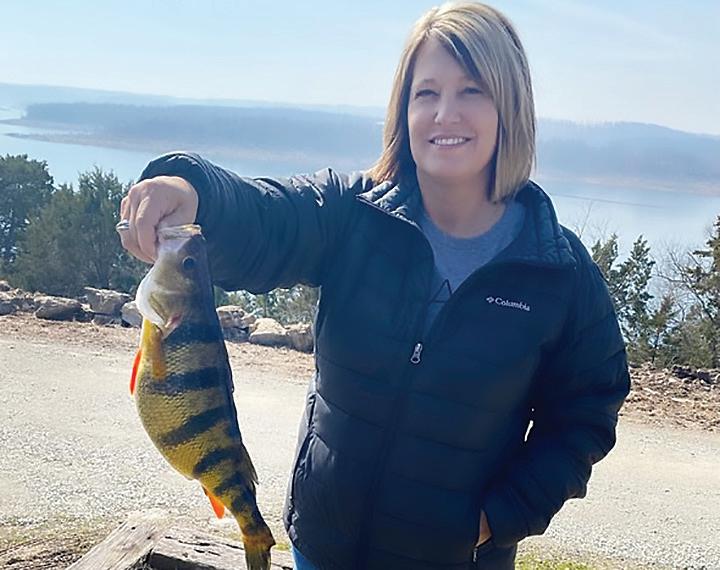
Sharon Christopher says she is not an ‘avid fisherman’ but that didn’t keep her from landing this yellow perch at 2 lbs., 7 ounces, the first state record catch of 2021 in Missouri.
the perch was weighed on a certified scale at its Shepherd of the Hills Fish Hatchery in Branson.
“I’m super excited,” Christopher said. “Again, I got really lucky. I’m a nurse and work a lot of long hours. I use fishing as a way to relax and enjoy myself, so when I caught this, I was showing everyone I work with the pictures!”
The previous record was a 2-lb., 3-ounce fish caught from Bull Shoals Lake in January 2020.
Christopher said her fish is going to be mounted.
“The funny thing is I do not eat fish,” she said. “My neighbor’s son is a taxidermist, and he is mounting the fish for us.”
Missouri state-record fish are recognized in two categories: pole-and-line and alternative methods that include trotlines, throwlines, limblines, banklines, juglines, spearfishing, snagging, snaring, gigging, grabbing, archery, and atlatl. For more information, go online to http://bit.ly/2efqlvl.
EXPERIENCE ELLINGTON
missouri explorethe& outdoors

ellingtonmo.com
Hike the
ozark trail
~ Only 2 Hours South of St. Louis ~
1Clearwater Lake & Webb Creek Park – Hwy H –Bring the family to camp, boat, fish, and unwind on crystal clear Clearwater Lake. This area of the lake is formed where Webb Creek and Logan Creek empty into Clearwater Lake. The lake is known for its crappie, catfish and bass fishing. Camping is available at Webb Creek Recreation Park; plus a full service marina with boat/wave runner rentals on site. Webb Creek Park features over 40 campsites, swim beach, Webb Creek Marina playground, showers, picnic pavilions, boat launch, and more. Services are limited after mid-September but camping is still permitted. Call Webb Creek Marina at 573-461-2344 for marina, boat rental and campsite information or visit www.recreation.gov to make reservations. If you are interested in all the conveniences of home call Webb Creek Cabins for cabin rentals, 573-461-2244. 2 Black River and K Bridge Recreation Area Hwy – Float, canoe, fish and explore the beautiful – K
Black River. Enjoy swimming, camping and picnicking right on the banks of the Black River. K Bridge Recreation Area and Campground offers playground, showers, electric and comfort station, visit www. recreation.gov to make reservations. Floats (raft or canoe) can be arranged on site by calling Jeff’s Canoe Rental at 573-598-4555. A small Highway K Camping general store is also available on site. 3 Current River & Log Yard Gravel Bar – Hwy 106 to HH Highway- Fish, swim, camp and relax on majestic Current River. Great place to explore Current River.
This area is often referred to as Cardareva by locals and is a favorite summer hangout. Primitive camping is available right on the river bank, camping is also available at the nearby School Yard with picnic tables, lantern hooks and fire pits. These sites are available on a first come basis. Bring your canoes, rafts and kayaks; a perfect day float….Powder Mill to Log Yard. Camp Current River Boat launch available. Powder Mill Recreation Area and Campground re-opened. Camping available with views of the Current River. Picnic table, firepit & lantern hook available at each site, reservations not available. Water/elect not provided. 5 Rocky Falls- NN Hwy- A cascading crystal Rocky Creek drops from the Ozark Mountains into a lazy pool which eventually winds through the Ozarks to Current River. A must see if you are in the area and fun for all ages. Wear non-slip shoes and use caution when climbing on the falls. Picnic tables provided.
4Current River, Blue Spring & Powder Mill Recreation Area – Hwy 106 near Current River bridge
Powder Mill reopened summer 2020. Camping is available with views of the river, picnic tables, fire pit and lantern hook. Reservations are not available. Powder Mill is a perfect camp base for day trips to area attractions like Blue Spring, Rocky Falls, Peck Ranch, Johnson Shut-Ins, Elephant Rocks and more. Wild horses are often seen in the fields near the bridge. The Ozarks offers countless Blue Springoptions for family adventure. 6 Current River Conservation Area –Consists of 28,000 acres of state land. Deer, turkey, eagles, elk and a multitude of wildlife can be seen. UTV’s, ATV’s and vehicle traffic are welcome on miles of gravel roads and trails that wind through some 60+ food plots. Buford Pond, Missouri’s first fire tower, a 1926 log cabin and an earthen Fort Barnesville can all be found here. Buford Pond provides fishing and picnicking and is a favorite location of all. For hunting enthusiasts an unstaffed rifle and archery range are provided.
Current River Conservation Area is home to the Missouri Ozark Ecosystem Project, the world’s most comprehensive forest management study. This 100 year project spans over 9,000 acres.
Main park entrance located on South Road in Ellington, other entrances located off Hwy 106 and HH highway. Primitive camping is available. Elk viewing and maps of the area are available at the main park entrance. 7 Local Flavor – While in town you won’t want to miss the Reynolds
County Museum. This Museum is filled with relicts from days gone by and the rich history of the Ozarks. Volunteers staff the establishment and are happy to answer questions; Open March-November, Tues-Fri, 10-4 or by Reynolds Co Museum appointment. Call 573-663-3233 for more information. Want some nostalgia from a couple decades back; how about a drive in movie? One of only a few drive-ins left in the
Wild Horses Midwest is located just south of Ellington on highway 21. 21 Drive-In opens in May with summer family favorites and offers movie events into the fall including Halloween and Christmas.
Blair Creek- Hwy 106 – This area is a favorite of the local’s spring, summer and fall. For the person who is looking for the unknown, adventure into the wild Ozark hills for the beautiful views, caves, swimming, picnicking. Here riding the back roads in ATV’s, UTV’s and 4-wheel drives is exciting and fun. Entrance located North of Hwy 106 across from Blue Spring entrance.
Ozark Trail- Hwy 106- Blair Creek & Current River section; Hwy 106 – Whether you are looking for a one day hike or want to make a few days of it; hiking these sections of the Ozark Trail is rewarding and adventurous. Such splendid locations as Rocky Falls, Klepzig Mill and Buzzard Mountain Shut-Ins are located right on the trail. For the adventurous visitor this is a must!
Peck Ranch- H Highway, Shannon County- Listen for the bugle this fall! Elk are now roaming the hills of the Ozarks and can be seen in Peck Ranch, Current River Conservation Area and the surrounding region. Thanks to the Missouri Department of Conservation’s recent Elk Restoration Program elk were released into the elk zone beginning in the summer of 2011. With the third release the summer of 2013 the elk herd is nearing 200 bulls, cows and calves. Peck Ranch is open from sunrise/sunset daily and offers a driving tour. Bugling occurs in the fall, Sept-Nov. Check the Missouri Dept of Conservation website for park closing details. Maps are available at park entrance. 8 Scenic Highway 106 - This 26 mile drive between Ellington and
Eminence is known state wide for its scenic views and beauty, and is especially a favorite in the fall. This section of highway is also home to the Trans-America Trail and sees many bicycle travelers from April-October. Bicycle enthusiasts say it’s one of the “toughest sections on the trail” and known for the steep hills & hollers.
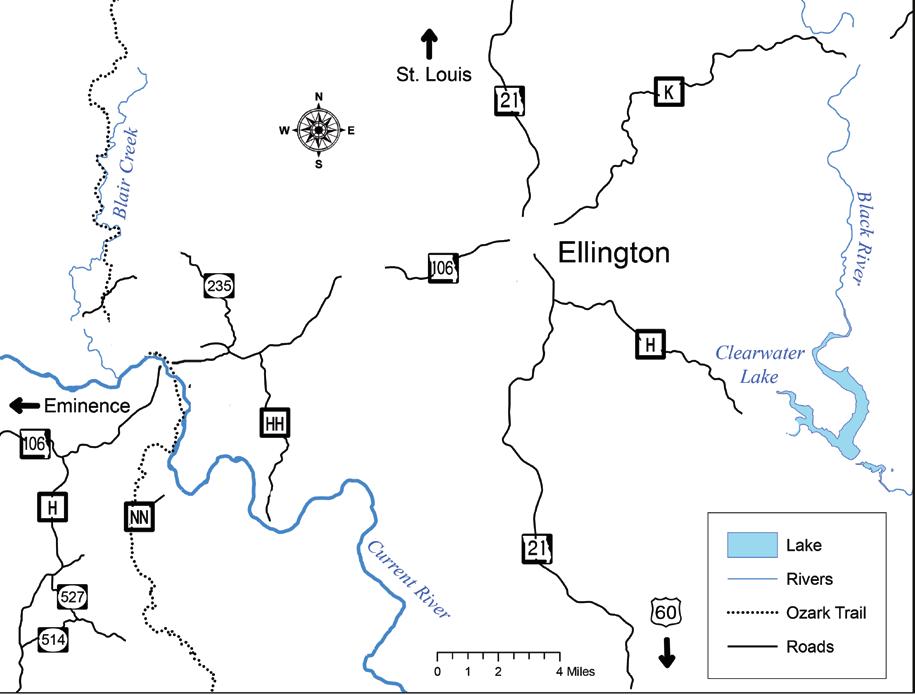
TransAmerica Trail
9
Blair Creek
10
Klepzig Mill
11 Elk
9
10
4
5
11 3 8 6 7
1
Get ready for the turkey hunt
Photo and Text By BRANDON BUTLER
It’s not all fun and games. Being an avid sportsman takes work and dedication. Firearm turkey season in Missouri lasts through May 9 and returns for the month of October, and the first order of business is making sure your turkey gun is ready to go.
Now, if you’re like me, Editorial you treat your gun like a tool, not a fine European sports car. I can hear Grandpa harping at me still, “Boy, you’d better take care of that shotgun.” And I do, to a point. I’m not what one would call an abusive gun owner, but I probably don’t give my firearms all the attention they deserve. So it’s time to make sure the old shotgun still functions properly.
This begins with a simple check of the mechanics. Does the action still work? Does it cycle properly? Add a little oil here, tighten a screw there. Then take it out back and fire a load at a target. Is it still shooting straight? If your pattern is good, be stingy on the practice rounds.
STILL RATTLING AROUND
Hopefully, you still have a few shells from last year rattling around in your gear box. There are many different specialized turkey loads on the market available in different load size and shell length. Longer shells usually hold more powder and pellets than shorter ones. Shot sizes of 4, 5 and 6 are all adequate and commonly used.
A turkey choke tightens your load of pellets for an extended range, meaning more pellets hit the target down range. When shooting a turkey, aim for the head. A tighter group allows you to shoot turkeys further away. A 40-yard shot is a long one. I caution you not to try shots any further than that.
CAMOUFLAGE MATTERS
The older I get, the more I deer-hunt in blue jeans or rugged brown pants. You can do this with turkey hunting, but camouflage clothing is much more important when chasing gobblers, because they see in color.
Turkeys are also very keen at detecting motion. Being covered from head to toe in a camouflage pattern that blends with your surroundings helps you remain undetected. You should also wear a facemask and gloves.
Having a good camouflage rain suit is also important if you are not hunting in a blind. Weather is often unpredictable during spring, so be sure to have a collection of clothes adequate for a wide range of temperatures and conditions. The grass is usually wet with dew in the morning, and the smallest of creeks can quickly fill with rushing water, so knee-high rubber boots are the way to go.
VEST OR PACK?
My turkey vest has seen its better days, but I still wear it. I find the vest the most convenient way of storing, organizing and accessing my gear. There are many models available, from the very basic with a few pockets, to technologically advanced systems with built in hydration packs or back support poles.
The right vest for you should have enough pockets to keep all your gear secure, without being too bulky when moving through the woods.
If you are planning to take more along in the turkey woods than the basic necessities, then you can carry a backpack or fanny pack. They’ll hold much more turkey hunting equipment, like a thermos of coffee or good book, than a turkey hunting vest does.
ABOUT CALLS…
With so many different calls on the market, choosing one style over another can be overwhelming to a beginning turkey hunter. Mouth calls, slate calls, box calls, push button calls, wing bone calls and locator calls all have their place in the grand scheme of turkey calling. When you’re first learning, box calls and push button calls are the easiest to use.
Practice is important before hitting the woods. Even with the simplest call in hand, you still need to produce a realistic sound. There are thousands of videos on YouTube.
Nothing compares to learning from the real thing, though. Spend time in the woods just listening for turkeys. Eventually, you’ll hear clucks, putts, cackles, cutts, purrs, yelps, kee kees, gobbles and more.
Work on producing clucks and yelps. These two calls have led to the demise of more gobblers than all the rest combined.
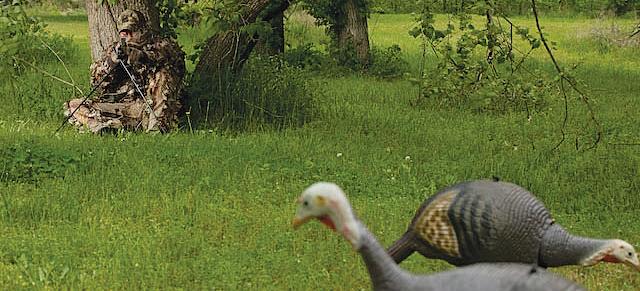
The Life Outdoors
Backyard archery is great fun and a good stress reliever
By RICHARD AITES
MY FIRST BOW
It was the early ‘80s, and I was in junior high school when I happened upon the little recurve bow at a local garage sale. My father was able to talk the original owner down to 10 bucks, which included three slightly used arrows.
Both the bow (a Fred Bear Golden Fox) and the arrows were made of solid fiberglass. I remember painting the arrow nocks with florescent-orange model paint, because money was tight back then and I couldn’t afford to lose any of my arrows.
I also fashioned a finger tab from a piece of worn shoe leather and constructed a target from a heavy-ply cardboard box packed tightly with old clothes and linens.
Grandfather’s place sat high atop a hill in rural Venango County, PA. Behind his meager house was a small orchard, and beyond the half-dozen or so apple trees were thousands of acres of state game land. Many late afternoons, after school, were spent in that orchard flinging arrows at my homemade target.
Eventually, after much practice, I found my form and became good enough to occasionally split an apple at 20 paces.
Confident in my newly acquired skill, it wasn’t long before I began exploring the woods behind my Grandpa’s property with the little bow in tow.
GREAT FUN, SMALL GAME
Because it had only a 30- or 35-lb. draw weight, the little recurve wasn’t adequate or legal for deer, but it was plenty powerful for small game and varmints.
A friend of mine suggested that I place a small metal washer behind each field point to add weight for more knockdown power. This also helped to keep the arrows from being lost in the brush. I found this set-up worked quite well for anything from bullfrogs to carp to rabbits.
Though misses were more common than hits, if I got close enough and did my part, no small game animal was safe from the mystical flight of my arrow (as Uncle Ted would say).
One warm, autumn day, I was able to stalk to within 20 yards of a portly groundhog that was grazing in a nearby meadow. With a perfectly placed arrow, the plump “woodchuck” would become the largest critter I’d ever take with that bow. And if my memory serves me well, I took quite a few squirrels and a couple of rabbits with the little bow. On one occasion I even knocked some tail feathers off a grouse (but that’s another story).
‘ROBIN HOOD’ GROWS UP
In 1985 I graduated from high school and went into the military. Upon completion of my service, I relocated to the Midwest, where I have been ever since. Through the years I’ve owned a couple of compound bows and even harvested a deer with one, but just recently, after nearly four decades, I found myself longing for a more traditional-style bow again.
I came across a Samick Sage on Amazon for a decent price and decided to give it a try. This take-down recurve came with 45-lb. limbs and is perfect for me because it is comfortable to draw and shoot and is legal for hunting here in Missouri.
More recently, my wife gave me a one-piece recurve bow for Christmas. It’s also a Samick (Red Stag) and its sleek lines and handsome laminations make it a delight to own and shoot.
BACKYARD RANGE
I am fortunate to have a decent-sized (half-acre) backyard with a privacy fence that surrounds most of the property. I can shoot my bows at known ranges of 5 to 30 yards and do it safely because I have reinforced the tall fencing behind the target area.
As for targets, I like to use the standard “block” or the heavy bag targets like Morrell produces. Just remember that SAFETY is the number one priority. Whenever you release an arrow, you are responsible for it.
Whether that arrow is moving 100 fps or 400 fps (feet per second), equipped with field point or hunting broadhead, it is your responsibility to assure that the impact is limited to your intended target.
And I can’t reiterate enough the importance of knowing what’s behind your target at all times.
If you are not fortunate enough to have a secluded backyard or your local ordinances do not permit the use of archery equipment within city limits, there are alternatives. Some conservation areas like August A. Busch here in St. Charles, have wonderful static and 3-D ranges available to the public. My brother’s hometown in north St. Louis County allows resident archers to use the outdoor range at the municipal sports complex. The range is within a half- mile of his house. You could even join a local archery club.
GIVE IT A TRY
I find traditional archery a great reliever of stress. If I’ve had a long day at work, there’s nothing more relaxing or gratifying (other than an alcoholic beverage or two) then sticking a few dozen arrows into a target at varying ranges. Now, at 54, it’s taking me a little longer to hone my skills, but the fun of being 14 again, at least for the moment, has returned.
And if I become proficient enough to split an apple at 20 paces, I may return to the woods with one of my new bows during Missouri’s generously long archery season.
Traditional archery is relatively inexpensive if you shop around. You can find Samick recurve bows on Amazon or EBay for around $120 to $200, depending on the model. The SAS Spirit, which is also a good beginners’ bow, can be had for under $100. Carbon arrows are all over the internet and can be relatively cheap. Remember, you don’t need high-quality hunting arrows for backyard target shooting.
If you give traditional archery a try, I’m sure you’ll find it a relaxing, if not rewarding,
Claudette’s Kitchen
Asparagus, spring’s finest gift
By CLAUDETTE ROPER
It’s hard to believe that our garden, which not long ago was piled high with snow, soon was yielding one of our favorite spring vegetables – asparagus.
While it gets rave reviews in our family, I have encountered folks who say they don’t like it. It’s interesting how many people come to dinner and say they don’t like asparagus, only to try it and like it. So what’s that all about? I don’t think they lied, because they had second helpings.
It’s no secret that the quality of the vegetable and the mode of preparation are crucial. Regarding the latter, I liked how they phrase it at the Bon Appétit website: “heinous crimes against asparagus.” We are going to explore some of these crimes and debunk a few myths.
THIN STALKS OR FAT?
A dear friend told me that she doesn’t often prepare asparagus, although she loves it, because she can’t often find the very thin, tender spears at the grocery store. Some “experts” claim that the thinner stalks are more tender and fat stalks are not. If you’ve cooked enough asparagus, you have discovered that this is just not true.
Being the tightwad that I am, it’s pretty hard for me to lay down the cash for a bunch of asparagus at the grocery store, let alone buying several bunches just to experiment. However, thanks to Mountain Man, we have almost 200 square feet of asparagus beds. He manages to keep them producing from spring well into the summer.
This has afforded me the opportunity to pick any length and any thickness desired. The results? Some thin ones are very tough, as are some fat ones!
I’m sure you don’t find that very helpful except to say that you’ll occasionally get a tough one. We also learned that if the stalk is skinny it won’t get much thicker as it gets taller.
From a practical standpoint, it is ideal to have similar-sized stalks so they will cook evenly. Realistically, I’m going to cook all sizes and, to deal with concerns about overcooking the thin ones, they get added a little after the bigger ones go in.
MYTH OF PEELING
Peeling your asparagus is another myth (in my humble opinion). Anyone who has read my articles for any amount of time knows that I’m not big on gadgets. Somewhere in this house there’s still an asparagus peeler tucked away. It was my mom’s – I can still see the pink plastic handle in my mind.
It’s nostalgia, nothing more. She was an unbelievably good cook, but she was wrong on this one.
HOW MUCH TO CUT?
Deciding how much to cut off from the bottom is another challenge. They say that if you bend an asparagus spear to the point of breaking, it’ll snap off exactly at the woody, tough part. I was doing that for a while, but it seemed so wasteful. Still, if done cautiously, it seems to be the best way.
See CAUDETTE’S page 12
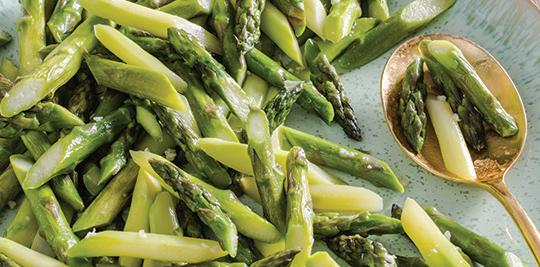
People who don’t like asparagus may have just not had it done right, like this dish of peeled but not snapped asparagus. – Cook’s Illustrated photo.



